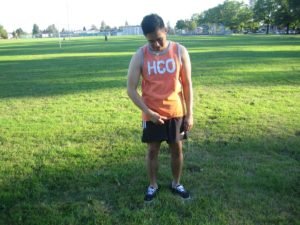A groin pull is best described as a painful tear at the adductor muscles. In this injury, the small fibers that form the three muscles running down the interior of the thigh up to the knee are torn due to unexpected stress, overstretching, and direct blow to the interior leg or even overuse. A pulled groin can be easily treated at home in order to promote the healing process.
Causes of a pulled groin
An individual is at higher risk for a pulled groin if he/she engages in certain activities. Initially, the adductor muscles are likely to tear if the individual is engaged in sports that involve abrupt movements such as in football, soccer, rugby, basketball and athletics. Even if the individual is tired, a tear can also occur. Overextension and lack of stretching can lead to a pulled groin as well as working out in cold weather.

Grading of the pulled groin
You can suspect a pulled groin if there is bruising, pain, tenderness or stiffness in the interior thighs and the groin. Another indication is the weakness of the adductor muscles and you can even hear a popping sound as the injury occurs. After the assessment, the doctor can rate the groin pull as grade 1, grade 2 or grade 3.
- Grade 1 – the adductors have been stretched and there is minimal micro-tearing of the muscle fibers. The recovery usually takes up to 2 weeks.
- Grade 2 – involves partial tearing of the adductor fibers. The healing can take up to 2 months.
- Grade 3 – the muscle is completely torn and the recovery period can take up to three or more months.
First aid care
If the individual has a pulled groin, basic first aid measures that you can learn in a first aid course can help out a lot. Initially, avoid activities that can further aggravate the injury. The individual might even walk differently by shortening the stride. Engaging in sports can be resumed only after the pain has completely stopped. For the initial 24 hours, the leg must be elevated to minimize the swelling.
Wrap the thigh using an Ace bandage or cloth to prevent swelling, but make sure that it is not too tight. You should also apply ice for the initial days for relief. The ice must be wrapped in a clean towel or cloth before applying to the muscles for 15-20 minutes for 4 times in a day. Over-the-counter medications for pain can also be given for pain relief.
Resuming activity
Once the individual resumes physical activity, there are changes to the treatment. Instead of ice, apply heat on the injured muscle. This is effective before stretching or any activity. Once the acute pain diminishes, the doctor can recommend stretching exercises several times in a day. Physical therapy is also recommended which includes stretching exercises to help prevent future injuries.
Prevention
The best way to avoid a pulled groin is to develop the adductor muscles. In doing so, it will allow the muscles to bear up when under stress. Do not simply neglect the adductor muscles when stretching. It is recommended to learn the correct sports techniques in order to avoid unwanted stress on the adductors.
